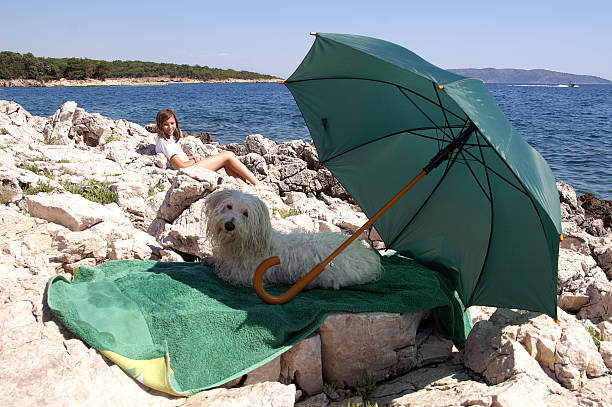As the days get longer and the sun shines brighter, it’s not just humans who need to be mindful of sun exposure—our pets do too. Pets, especially those with short fur, light-colored coats, or hairless breeds, can be particularly susceptible to the harmful effects of the sun. Protecting your pets from sunburn and other sun-related health issues is essential to keeping them safe and comfortable. This blog post will guide you through the best practices for choosing the right sun protection for your pets.
Understanding the Risks of Sun Exposure

1. Sunburn:
- Susceptible Areas: Pets can get sunburned on their nose, ears, belly, and any areas with thin or light fur. Sunburn can be painful and lead to peeling, redness, and even skin cancer over time.
- Signs of Sunburn: Redness, swelling, and tenderness on the skin are common signs. You may also notice your pet scratching or licking the affected area.
2. Heatstroke:
- Symptoms: Excessive panting, drooling, vomiting, and lethargy can indicate heatstroke, a serious condition that requires immediate veterinary attention.
- Prevention: Keeping pets cool and hydrated is crucial in preventing heatstroke.
3. Skin Cancer:
- Types: Pets, like humans, can develop skin cancer due to excessive sun exposure. Squamous cell carcinoma is the most common type related to sun damage in pets.
- Prevention: Limiting sun exposure and using protective measures can reduce the risk.
Sun Protection Options for Pets

1. Pet-Friendly Sunscreen:
- Formulation: Choose a sunscreen specifically formulated for pets. Human sunscreen can contain ingredients that are toxic to animals, such as zinc oxide and PABA.
- Application: Apply sunscreen to vulnerable areas like the nose, ears, belly, and any other exposed skin. Reapply as needed, especially if your pet is swimming or sweating.
- Example Products: Look for brands like Epi-Pet Sun Protector Spray or Petkin Doggy Sunstick.
2. Protective Clothing:
- UV-Blocking Apparel: Clothing designed to block UV rays can be highly effective. These garments often cover more of your pet’s body, providing comprehensive protection.
- Comfortable Fit: Ensure the clothing is comfortable and doesn’t restrict movement. Lightweight, breathable fabrics are ideal for keeping pets cool.
- Example Products: Consider brands like Ruffwear Sun Shower Jacket or Hurtta Cooling Vest.
3. Shade and Shelter:
- Provide Shade: Always provide shaded areas for your pets when they are outdoors. Use umbrellas, canopies, or trees to create shaded spots in your yard.
- Indoor Breaks: On extremely hot days, limit outdoor activities and allow your pets to spend more time indoors in a cool environment.
4. Avoid Peak Sun Hours:
- Timing: Avoid taking your pets outside during peak sun hours, typically between 10 a.m. and 4 p.m. Early morning or late evening walks are safer and more comfortable.
5. Hydration:
- Fresh Water: Ensure your pets have access to fresh, cool water at all times. Dehydration can exacerbate the effects of sun exposure.
- Hydrating Foods: Consider offering hydrating snacks like watermelon (without seeds) and cucumbers to keep your pets hydrated.
Special Considerations for Different Pets

1. Dogs:
- Breed-Specific Needs: Dogs with light-colored fur, thin coats, or hairless breeds like the Chinese Crested are more prone to sunburn. Pay extra attention to these breeds.
- Nose Protection: Apply pet-safe sunscreen to the nose, as this area is particularly vulnerable.
2. Cats:
- Indoor Cats: Even indoor cats can be exposed to harmful UV rays through windows. Use UV-blocking window films or keep blinds closed during peak sun hours.
- Outdoor Cats: For cats that spend time outdoors, ensure they have access to shaded areas and apply pet-safe sunscreen to their ears and nose.
3. Small Pets and Exotics:
- Rabbits and Guinea Pigs: These pets are sensitive to heat and should always have access to shade and cool environments. Avoid direct sunlight exposure.
- Reptiles: Provide shaded areas in their enclosures and ensure they have access to both warm basking spots and cooler areas to regulate their temperature.
Tips for Applying Sunscreen to Pets

1. Test for Allergies:
- Patch Test: Apply a small amount of sunscreen to a small area and monitor for any allergic reactions such as redness or itching.
2. Calm Environment:
- Positive Experience: Apply sunscreen in a calm and positive environment. Use treats and praise to make the experience pleasant for your pet.
3. Reapply as Needed:
- Frequency: Reapply sunscreen every few hours, especially if your pet is swimming or playing in water. Check the product instructions for specific reapplication guidelines.
Protecting your pets from the sun is crucial for their health and well-being. By using pet-safe sunscreens, UV-blocking clothing, providing plenty of shade, and ensuring they stay hydrated, you can keep your pets safe and comfortable during the sunny months. Remember to consider your pet’s specific needs and consult with your veterinarian if you have any concerns about sun protection for your furry friends. With these measures in place, you and your pets can enjoy the summer sun safely.
Subscribe to the Gingr Blog






